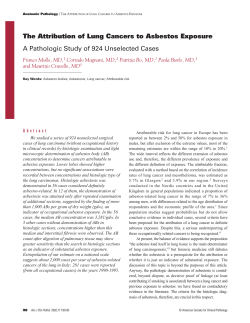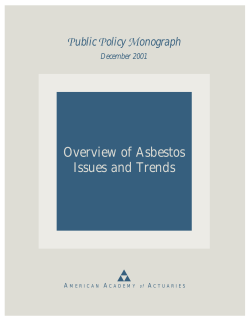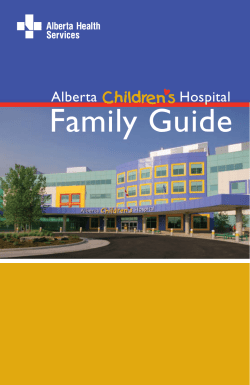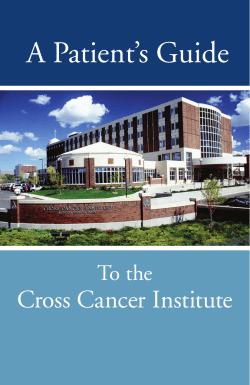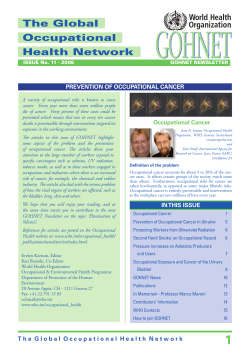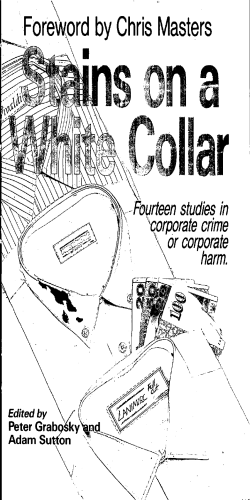
The Implosion of the Calgary General Hospital: Ambient Air Quality Issues
TECHNICAL PAPER ISSN 1047-3289 J. Air & Waste Manage. Assoc. 55:52–59 Copyright 2005 Air & Waste Management Association The Implosion of the Calgary General Hospital: Ambient Air Quality Issues Dennis Stefani Risk Assessment and Management Section, Environmental Health, Calgary Health Region, Alberta, Canada Dennis Wardman First Nations and Inuit Health, Health Canada, Vancouver, British Columbia, Canada Timothy Lambert Risk Assessment and Management Section, Environmental Health, Calgary Health Region, Alberta, Canada ABSTRACT This paper discusses the implosion of a large inner-city hospital in Calgary, Alberta, Canada, on October 4, 1998. Stationary and mobile air monitoring conducted after the implosion indicated there were several short-term air quality issues, including significant temporal increases in total suspended particles, particulate matter (PM) with aerodynamic diameter less than or equal to 10 m (PM10), PM with aerodynamic diameter less than or equal to 2.5 m (PM2.5), asbestos, and airborne and settled lead. In addition, the implosion created a dust cloud that traveled much further than expected, out to 20 km. The ability of an implosion to effectively aerosolize building materials requires the removal of all friable and nonfriable forms of asbestos and all Pb-containing painted surfaces during pre-implosion preparatory work. Public advisories to mitigate personal exposure and indoor migration of the implosion dust cloud constituents should extend to 10 or 20 km around an implosion site. These findings point to a number of complex and problematic issues regarding implosions and safeguarding IMPLICATIONS The ability of an implosion to effectively aerosolize building materials indicates that all lead painted surfaces and nonfriable and friable asbestos-containing materials should be removed from a building during the preparatory work. The implosion dust cloud affected ambient air quality up to 20 kilometers downwind and suggests that public advisory zones around implosion sites should be extended. The necessity for large advisory zones in densely populated areas will be a challenge for the effective public communication of the health risks, mitigation, and cleanup strategies. We suggest that implosions should be prohibited in densely populated areas. 52 Journal of the Air & Waste Management Association human health and suggest that implosions in metropolitan areas should be prohibited. Further work to characterize the public health risks of conventional versus implosion demolition is recommended. INTRODUCTION In 1994, the province of Alberta underwent healthcare system regionalization, with one of the regions created being the Calgary Regional Health Authority (CRHA). As part of the CRHA’s restructuring plan, the buildings that comprised the Calgary General Hospital–Bow Valley Centre (BVC) were imploded on October 4, 1998. The hospital comprised numerous buildings constructed over an extended period of time beginning in 1910. In total, seven buildings over three stories in height and 84,000 m2 in area were imploded using ⬃2300 kg of explosives. The hospital was located within an older residential community. A concern regarding the building implosion was the generation of a large dust cloud that would engulf the adjacent residential area, buildings, and bystanders. The constituents of implosion dust clouds are largely unexplored, although they can reasonably be expected to reflect building material and soil constituents. A literature search has revealed very few published studies on implosion dust clouds. A hospital was imploded in Minneapolis, MN, in September 1981 during 16 –24 km/hr wind speeds and sunny skies.1 The investigators measured indoor and outdoor airborne fungal concentrations before and after the implosion. Depending on the species, outdoor concentrations increased up to 3 orders of magnitude at 60 m from the implosion site. Smaller increases (⬍10 times) were observed indoors in adjacent hospital buildings, relative to indoor backgrounds, and reflect staff efforts to seal the building before demolition. Heating, ventilation, and air Volume 55 January 2005 Stefani, Wardman, and Lambert Figure 1. Map of the Bow Valley Centre implosion site showing stationary monitoring locations, Calgary, Alberta. conditioning systems were operated in the 100% recirculation mode, and the outdoor air intakes were sealed. Anecdotally, the Baltimore City Health Department2 and Las Vegas County3 reported large implosion dust clouds that dissipated in 20 –30 min at ⬃1 km distance. Reported PM10 concentrations in the dust cloud ranged from 150 to 200 g/m3. Thick dust coatings on nearby vehicles and buildings suggest that very large particulates quickly settled out of the dust cloud. Because some dust was anticipated from the implosion, residents within 1 km surrounding the BVC were advised to close windows and doors, seal them, and leave the area to mitigate any exposures. This distance was based on anecdotal information that the dust cloud would dissipate within 1 km of the implosion site. Contrary to this advice, many people congregated around the site in a festive atmosphere to witness the implosion. Before the implosion, all friable and some nonfriable asbestos was removed from the structures. Lead (Pb) present in the paint because of the age of the building was assumed to have an insignificant impact on air quality or deposition. Because of the limited literature on implosions, these findings can be a useful planning tool for managing future implosions and future research. OBJECTIVES The study addressed four null hypotheses: (1) the implosion of the BVC will generate a pollutant cloud above ambient guidelines within 1 km of the implosion site; (2) there will be insignificant ambient levels and public health risks from Pb and asbestos within 1 km of the site Volume 55 January 2005 because of the removal of friable and some nonfriable asbestos and the assumption of negligible Pb; (3) the implosion cloud will not affect ambient air quality beyond 1 km; and (4) the implosion will not result in an elevated health risk for residents beyond 1 km. The hypotheses were tested by measuring pre-implosion, implosion, and post-implosion air quality for total suspended particles (TSP), airborne asbestos, and airborne and deposited Pb. The dynamics of the implosion dust cloud dissipation was followed with time in terms of TSP, inhalable PM10 (particle size ⬍10 m diameter), and respirable PM2.5 (particle size ⬍2.5 m diameter). The concentrations of the pollutants generated in the implosion were compared against guidelines indicating potential public health risks. METHODS Air Monitoring Fixed and mobile air monitoring occurred before, during, and post-implosion. Fixed air sampling locations for TSP (Alberta Environment Method A-8 –1), PCM (Phase Contrast Microscopy) asbestos (National Institute for Occupational Safety and Health [NIOSH] #7400), transmission electron microscopy (TEM) asbestos (NIOSH #7402), Pb (U.S. Environmental Protection Agency Method #3051), and surfacedeposited Pb (U.S. Department of Housing and Urban Development [HUD] Title X) are shown in Figure 1. The hospital occupies a large area of the primary evacuation zone identified in the figure. Alberta Environment’s mobile monitoring vehicle was used to record TSP, PM10, and PM2.5 (Grimm 1.105 laser dispersion). Ambient air quality data also were obtained from the permanent Alberta Journal of the Air & Waste Management Association 53 Stefani, Wardman, and Lambert Environment air monitoring station located 2 km southwest in downtown Calgary. Fixed sampling consisted of background 24-hr average concentrations before the blast, during, and immediately after the implosion (measured concentrations between 8:00 a.m. and 11:00 a.m. on October 4), postimplosion (between 11:00 a.m. and 8:00 a.m. the next day), and a calculated 24-hr average between 8:00 a.m. on October 4 and 8:00 a.m. on October 5). The implosion occurred October 4, 1998, at 8:00 a.m. Alberta Public Works, Supply & Services did all of the stationary sampling through their consultant, PHH Environmental. The Alberta Environment mobile monitoring vehicle was used to follow visually the path of the dust cloud along its southeastern course. Peak or maximum 1-min average concentrations were recorded from the vehicle. Health Risk Assessment The air quality data were compared with ambient air quality guidelines that were in place the year of the implosion (1998), and the analysis was updated with some current health risk information for acute exposures to PM2.5. Where there were no Alberta standards or guidelines, those from other jurisdictions were utilized. • TSP, 100 g/m3 24-hr average Alberta Ambient Air Quality Guideline as defined by Alberta Environment; • Airborne PCM asbestos fibers, 0.01 fibers/cm3, which is the Alberta indoor air clearance criterion following asbestos abatement; • Airborne Pb, 5 g/m3 24-hr average as defined by the Ontario government in the Ambient Air Quality Criteria Regulation;4 • Settled Pb dust as 500 – 800 g/ft2 as defined by HUD5 for interior window stills and window troughs in homes; and • Mice lungs instilled with 100 g of World Trade Center (WTC) PM2.5 surface dust demonstrated lung inflammation and airway hyper-responsiveness with methacholine challenge, which was estimated to be equivalent to a human inhalation concentration of 450 g/m3.6 The authors estimated that active healthy workers exposed to this concentration over an 8-hr period would develop lung inflammation, air hyper-responsiveness, and upper respiratory tract irritation. Hypersusceptibles, such as asthmatics, were thought to develop these problems at lower doses. The NOAEL (No Observable Adverse Effect Level) in this study was a mouse dose of 31.6 g, equivalent to an 8-hr hard-working adult exposure of 134 g/m3. There are numerous protocols for deriving reference concentrations or ambient air quality guidelines aimed at 54 Journal of the Air & Waste Management Association public health protection from animal studies.7–9 Using the NOAEL approach, it would not be unusual to apply up to an order of magnitude reduction to the dose-adjusted human equivalent concentration to account for hypersusceptibles in the human population. The experimental NOAEL dose for mice in the WTC study was 31.6 g for PM2.5 dust, equivalent to a resting adult human inhalation concentration after 15-min exposure at 20 m3/day of 9200 g/m3. It would be prudent to lower this concentration to be protective of hypersusceptibles within the general population. In consideration of a possible 10⫻ adjustment, the recommended public health guideline for the prevention of noncancer acute adverse respiratory effects from implosion dust cloud PM2.5 is 920 g/m3 for a short-term exposure of 15 min. The literature was searched to find methods for shortterm cancer risk assessment. Because none were found, cancer risk for asbestos exposure for the short period was amortized over a lifetime. An acute exposure factor was included to account for the increased potency of carcinogens with short-term exposure based on the observations of short-term exposure to polycyclic aromatic hydrocarbons (PAHs) and development of cancer. Acute health risks for exposure to implosion dust were evaluated by comparison with the toxicological data from the dust generated from the WTC collapse. RESULTS On the morning of the implosion, the weather conditions were as follows: clear sky, temperature 8 °C, and wind from the northwest at 7 km/hr (ground level). The results of monitoring are displayed in Table 1 for the fixed air sampling locations and in Table 2 for the mobile monitoring. The fixed pre-implosion monitoring sample results established background concentrations of TSP, asbestos, and airborne and surface Pb (Tables 1 and 2). For mobile monitoring results, the permanently located Alberta Environment air monitoring station in downtown Calgary 2 km to the southwest provided additional estimates of background PM10 and PM2.5. Hourly average (range) PM10 and PM2.5 concentrations for October 4 were 8.9 (5–12.5) and 5.3 (3.5– 6.5) g/m3, respectively. For 1998, the hourly PM10 average and 98th percentile concentrations were 32 and 127 g/m3. For PM2.5 the average and 98th percentile were 13 and 38 g/m3. The mobile van provided 1-min average background estimates of TSP, PM10, and PM2.5 levels during the preimplosion period and on the half-hour drive back to the implosion site (9:32–10:05 a.m.) Average and (maximum) 1-min TSP, PM10, and PM2.5 concentrations on the drive back were 47 (338), 35 (264), and 8 (51) g/m3, respectively. Pre-implosion background measurements were considerably lower and reflect the influence of the early morning hours and site security. Volume 55 January 2005 Volume 55 January 2005 Table 1. Stationary ambient air quality monitoring data (Alberta Public Works, Supply & Services). Sample Locations Parameter Distance from Implosion site (m) TSP, g/m3 Pre-implosion (24-hr averages for Sept 26/ 27/Oct 3) Implosion (Oct 4 8:00–11:00 AM) Post-implosion (11:00–8:00 AM) Implosion and post-implosion (24-hr average) Airborne PCM asbestos, fibers/cm3 nd ⫽ no data #2 #3 #4 #5 #6 #7 300 west 50 north 200 northeast 50 east 400 southeast 50 south 550 east nd/nd/20.4 34.6 29.7 30 38.3/33.1/21.5 27.4 49.8 46.8 nd/nd/12.8 23.3 22 22.1 nd/nd/22 11880.8 212.2 1611.8 39.2/38.0/21.5 3273.4 122.9 515.9 nd/nd/30 27,406.6 390.6 3093.5 nd 5500 (22-min sample) nd nd nd/nd/ ⬍0.001 0.013 ⬍0.001 ⬍0.002 ⬍0.001/0.001/ ⬍0.001 ⬍0.006 0.001 ⬍0.002 nd/nd/ ⬍0.001 0.023 ⬍0.001 ⬍0.002 nd/nd/nd/ 0.003 0.128 0.008 0.024 ⬍0.001/⬍0.001/⬍0.001 0.065 0.004 0.012 nd/nd/nd 0.362 0.005 0.047 nd 1.88 (22-min sample) nd nd nd 0.09 ⬍0.0003 0.009 nd 0.08 (22-min sample) nd nd nd nd nd nd ⬍0.001/ ⬍0.001 nd nd nd nd nd nd nd nd 0.02 nd nd nd nd nd nd 0.004/nd nd nd nd nd nd/0.003 4.5 0.04 0.58 ⬍25 ⬍25 nd nd nd 107 55 ⬍25 ⬍25 ⬍25 239 ⬍0.001/⬍0.001 nd nd nd 0.004/0.003 nd nd nd ⬍25 44 nd/0.006 4.29 0.07 0.49 nd nd nd nd ⬍25 1347 (retest 1548) nd nd Stefani, Wardman, and Lambert Journal of the Air & Waste Management Association 55 Pre-implosion (24-hr averages for Sept 26/ 27/Oct 3) Implosion (8:00–11:00 AM) Post-implosion (11:00 AM-8:00 AM) Implosion and post-implosion (24-hr average) Airborne TEM asbestos, fibers/cm3 Pre-implosion (24-hr averages for Sept 26/ 27) Implosion (8:00–11:00 AM) Post-Implosion (11:00 AM-8:00 AM) Implosion and post-implosion (24-hr average) Airborne Pb, g/m3 Pre-implosion (24-hr average Sept 26/Oct 3) Implosion (8:00–11:00 AM) Post-Implosion (11:00–8:00 AM) Implosion and post-implosion (24-hr average) Pb in settled dust (wipe sampling), g/ft2 Pre-implosion (Oct 3) Post-implosion (Oct 4) #1 Stefani, Wardman, and Lambert Table 2. Mobile air monitoring data summary (Alberta Environment). Average (Maximum) 1-Min Concentration Location Pre-implosion, 500 m from site (southeast) Implosion occurs Post-implosion (PI), 500 m from site 5:00 8:08 8:14 8:16 6.5 (99) 4 (15) 1 (2) ⬎99,999 (86,179) ⬎99,999 (68,942) 14,456 (7363) ⵑ68,522 (includes ⬎99,999 measurements) (15,244) 15,412 (17,692) 5203 (7767) 923 (1047) ⵑ60,663 (includes ⬎99,999 measurements) (9571) 9050 (11,005) 4049 (5859) 740 (797) 7516 (785) 1674 (2367) 630 (825) 175 (190) 1817 (2858) 1821 (2264) 1100 (1237) (2632) (1266) 47 (338) 1351 (2101) 1394 (1709) 873 (965) (1358) (267) 35 (264) 242 (288) 227 (253) 152 (154) (42) (14) 8 (51) 305 (614) 161 (323) 11 (26) AM AM 8:21 AM 8:23–8:24 AM 8:33–8:38 AM 8:42–8:43 AM 8:51–855 AM PI, 17 km from site PI, 20 km from site PI, 25 km from site 9:03–9:04 AM 9:17–9:19 AM 9:28 AM 9:31 AM 9:32–10:05 PI, 500 m from site PM2.5 (g/m3) 10:08–10:36 AM Based on the stationary monitoring results, hypothesis 1 is accepted; a pollutant cloud above ambient guidelines within 1 km of the site was observed. The Alberta ambient air quality guideline for the 24-hr average implosion and post-implosion TSP was exceeded at locations 4, 5, 6, and likely 7, all within 1 km and downwind (southeast) from the implosion (Figure 1). Based on stationary monitoring results, the hypothesis that there would be insignificant levels of airborne and deposited Pb and airborne asbestos within 1 km is rejected. PCM asbestos concentrations exceeded airborne criteria at a number of downwind locations (Table 1). A number of exceedence samples were reanalyzed for TEM asbestos. Reanalysis results showed that the TEM asbestos concentrations were elevated at a number of downwind locations for the 3-hr monitoring period immediately following the implosion but were all below the guideline for calculated 24-hr average. The 24-hr average post-implosion airborne lead concentrations were elevated compared with normal background levels but were not above the 24-hr guideline. Wipe test results for Pb in settled dust ranged from “below detection limits” to a high of 1347 g/ft2 at location #6 (Table 1). The elevated Pb wipe sample at location #4 is equivalent to a soil mass concentration of 10 –15 ppm (assuming 1-cmdeep soil), which is roughly equivalent to background soil 56 Journal of the Air & Waste Management Association Comments Background AM 2.5 km from site 3 km from site 6 km from site 8 km from site 13 km from site PI, return to site PM10 (g/m3) AM–8:00 AM Average between 8:12 AM and 8:19 AM PI, PI, PI, PI, PI, TSP (g/m3) Time Location intermediate between stationary locations #7 and #5 The bulk of the dust cloud passed over monitoring van in 7 min Fluctuating values caused by the difficulty in tracking and staying in the dust cloud Background, upwind of dust cloud Cleaning activities underway (street sweeping) around BVC levels seen in the city of Calgary. However, the test results at location #6 were considered elevated based on the adopted HUD criterion. As a result, the building, playground equipment, and grounds in the area were washed down using fire hoses. The washing was effective in reducing the level as indicated by the post-washing test result average of 524 g/ft2 (n ⫽ 3). The hypothesis that the implosion would not result in an elevated health risk for nearby residents within 1 km from the site, with respect to asbestos, is accepted with reservation. The public exposure to airborne asbestos following the implosion was estimated at 1.08 TEM fibers/cm3 for a 15-min exposure. The maximum measured 3-hr average concentration of 0.09 TEM fibers/cm3 was conservatively extrapolated to a 15-min average of 1.08 TEM fibers/cm3 because the stationary mobile monitoring van near the implosion site indicated plume exposure lasted ⬃15 min because of winds. Assuming an inhalation rate of 20 m3/day, 2.25 ⫻ 105 TEM fibers would be inhaled during the 15-min exposure period. Over a lifetime, this would translate to an average exposure of 4.4 ⫻ 10⫺7 TEM fibers/cm3. The 10⫺6 cancer risk level for TEM asbestos of 2.5 ⫻ 10⫺6 fibers/cm3 was derived from the Health Effects Institute continuous outdoor lifetime risk estimates for combined lung cancer and mesothelioma, summarized by Volume 55 January 2005 Stefani, Wardman, and Lambert Agency for Toxic Substances and Disease Registry, Appendix D.10 The public cancer risk from asbestos exposure near the Bow Valley Centre implosion site from a 15-min exposure is estimated at 1.8 ⫻ 10⫺7 and is considered negligible. The null hypothesis that the BVC implosion will not affect ambient air quality beyond 1 km is rejected based on monitoring data. At 15-min post-implosion and 3 km southeast from the implosion site, 1-min average TSP, PM10, and PM2.5 levels from the mobile monitoring van were 15,412 and 9050 and 1674 g/m3. TSP and PM10 levels remained elevated relative to normal ambient background at 80 min post-implosion (9:28 and 9:31 a.m.) at a distance of 25 km. TSP and PM10 were 2632 and 1358 g/m3, respectively. At 42 g/m3, the PM2.5 measurement was considered to be within the range of expected background. However, an examination of PM (particulate matter) ratios revealed an anomaly at 80 min post-implosion that indicates dust cloud impact extended out to 70 min postimplosion or 20 km, not 25 km. PM ratios post-implosion up to 9:28 a.m. were very similar. TSP/PM10 ratios were generally between 1.7 and 1.1, PM10/PM2.5 between 12.2 and 4.2, and TSP/PM2.5 between 19 and 5.2. These ratios at 9:28 and 9:31 a.m. increased to 4.7, 32, and 90, respectively. This anomaly may be explained by the possible entrainment of PM originating from adjacent vehicles or trucks, such as vehicles disturbing curbside gravels. The upwind or background PM concentrations recorded on the drive back to the implosion site were significantly less than those measured at 9:28 and 9:31 a.m. In addition, the downwind TSP/PM10, PM10/PM2.5, and TSP/PM2.5 ratios were comparable to post-implosion downwind up to 9:28 a.m. and pre-implosion measurements. At these locations, TSP/PM10 were 1.3 and 1.6, PM10/PM2.5 were 4.4 and 4, and TSP/PM2.5 were 5.8 and 6.5, respectively. The fourth hypothesis that the implosion would not result in an elevated health risk for residents beyond 1 km from the site, with respect to PM2.5 and other PM, is rejected. We have assumed that the 15-min exposure estimate derived from the mobile monitor at 500 m from the site also is indicative of exposure duration further downwind. We also have extrapolated instantaneous monitoring van measurements to be indicative of a 15-min stationary public exposure. With these assumptions, it is estimated that exposures above the proposed public health guideline of 920 g/m3 PM2.5 15-min average occurred out to 4 or 5 km. DISCUSSION General Air Monitoring On October 4, 1998, the BVC hospital was imploded. Predictions of the dust that would be generated from the implosion were not considered to pose significant health risks to the neighboring population beyond 1 km. The resulting dust plume from the implosion was anticipated to dissipate Volume 55 January 2005 very quickly (minutes) and within a short distance from the site, a few hundred meters. Results confirmed the expectation of brief public exposure, but the implosion cloud traveled far beyond the expected 1-km maximum. These findings are supported in part by the hospital implosion study in Baltimore where exposure to a concentrated implosion dust cloud was brief, estimated at 20 min.11 Airborne 10-sec average PM10 concentrations increased from a background of 0.001 g/m3 to 54 mg/m3 at 100 m and to 0.6 mg/m3 at 200 m immediately following the implosion. PM10 concentrations returned to background 20 min post-implosion. Outdoor fungal aerosol concentrations were elevated several-fold at 100 and 200 m and two-fold at 400 m. However, contrary to expectations, our measurements showed that the dust cloud affected air quality 20 km downwind of the implosion site. The stationary monitoring results found that 24-hr average TSP and PCM asbestos levels on October 4 were elevated at locations 4, 5, 6, and likely 7 in comparison to the guideline and pre-implosion background measurements. Pb concentrations at 24 hr were below guideline at downwind sampling locations. A comparison of implosion and postimplosion measurements shows that TSP, PCM asbestos, and Pb levels fell rapidly after the implosion likely because of wind dispersion. The reductions would have been greater if post-implosion cleanup activities in the area were not disturbing the settled dust (e.g., road sweeping). The transient nature of the elevation in the levels of all contaminants and people’s brief exposure, estimated to be minutes, meant that the risk to the general population’s health was low. In addition, the advice given to people within 1 km of the site to stay indoors with windows and doors sealed or to leave the area helped to mitigate any exposures. Asbestos The elevations in downwind PCM asbestos concentrations above the guideline resulted in additional TEM reanalysis of a small subset of sample filters. Reanalysis confirmed the presence of elevations in TEM asbestos at downwind locations following the implosion. The downwind post-implosion TEM asbestos concentration returned to near background levels. There is no established method by which public cancer risk to a brief exposure to airborne asbestos during the implosion could be assessed accurately. Nevertheless, qualified insight into this question was estimated by amortizing the exposure over a lifetime, and the calculated public risk was estimated at 1.8 ⫻ 10⫺7 and is negligible. However, it is not appropriate to amortize short-term exposures over a lifetime or to calculate short-term risks using risk factors that were developed from long-term exposure. The primary reason is that the underlying biological mechanisms for cancer from long-term exposure Journal of the Air & Waste Management Association 57 Stefani, Wardman, and Lambert may not apply to acute exposures. Thus, a conclusion that the exposure represented negligible risk based on the risk estimate should be viewed very cautiously. The few studies on the cancer risk of short-term asbestos exposure are of limited quantitative value but do suggest that such exposures should not be disregarded.10 Muller,12 in an Ontario Government criteria document for PAHs, cites studies supporting short-term exposures as being 10 times more effective in causing cancer than the same total dose spread over a more prolonged exposure period. The increased vulnerability of children has been cited as a reason to increase cancer potencies by 10⫻.13 In the context of incremental cancer risk from asbestos exposure at the BVC implosion site, a 10⫻ adjustment in cancer potency does not alter the conclusion of negligible risk. However, the risk estimate cannot be considered inconsequential given the significance of the brief 15-min exposure to lifetime cancer risk. The lifetime exposure average for TEM asbestos fibers in urban areas of the United States is estimated at 0.0001 fibers/ cm3.10 The pre-implosion TEM asbestos concentrations were ⬍0.001 fibers/cm3. Particulate Matter The public health implications of noncancer health endpoints for the short-term exposure to implosion dust TSP, PM10, and PM2.5 also need to be considered. Studies following the catastrophic WTC collapse on September 11, 2001, provided some insight. No measurements of airborne concentrations of the cloud created by the collapse of the WTC were completed. Settled dust samples collected following the WTC collapse were alkaline in nature because of the dominant influence of aerosolized building material constituents such as concrete and gypsum.14 Although the expectation is that the PM2.5 fraction will consist of combustion-related particulates, strong mechanical forces also can generate PM2.5.15,16 Significant quantities of gypsum and calcium carbonate were found in WTC PM2.5 surface dust.14 Thus, the BVC implosion may have generated significant quantities of building material aerosols in TSP, PM10, and PM2.5 fractions. In terms of the BVC implosion, the proposed PM2.5 guideline of 920 g/m3 15-min average suggests that hypersusceptibles such as asthmatics or the elderly with compromised lung function may have been adversely affected by exposure to the implosion dust cloud as far as 4 or 5 km downwind from the implosion site. However, the finding by Gavett of bronchial hyper-responsiveness in mice and the observation of upper airway irritation of WTC workers, including wheezing, coughing, nose and throat irritation, and bronchial hyper-responsiveness, suggests the undetermined influence of coarse-fraction PM (PM10 –2.5), which is a PM10 component. In comparison to PM2.5, coarse-fraction PM preferentially deposits in the tracheobronchial tree. The 58 Journal of the Air & Waste Management Association implosion data indicate that the concentration of coarse fraction PM is 5 times larger than PM2.5 and, therefore, more likely to impact the upper airways. In addition, the inflammatory response in mouse lung may have been underestimated because the WTC dust used in testing may be considered weathered or aged, although the timing between sample collection and experimentation is unclear. Freshly fractured rock has been shown to be more inflammatory than weathered rock because of the presence of larger amounts free radicals on fresh rock cleavage planes.17,18 Thus, there is still concern about possible adverse health effects from brief public exposures to implosion dust clouds out to 10 or 20 km. Managing Implosion Health Risks The implosion generated levels of airborne Pb and TEM asbestos higher than the background levels recorded before the implosion. This indicates the physical ability of implosion forces to effectively aerosolize building materials into the air, including hazardous materials. Although the risk to health was deemed to be minimal because of short exposure times, it is still prudent to minimize public exposure to asbestos, which is a known human carcinogen,10 and to Pb, which is toxic at very low levels.19 The environmental monitoring data suggest, and it is recommended, that, before implosion, all nonfriable and friable asbestos and all Pb-containing surfaces should be removed to maintain airborne concentrations as close as possible to background levels and to minimize the risks associated with any surface deposition of airborne contaminants. Considerable effort was expended at the hospital in removing all friable and some nonfriable asbestoscontaining materials before the implosion. Nonfriable asbestos-suspect materials not assessed or removed included plaster, mortar, and floor tile. Although substantial quantities of Pb-containing coatings and paints were suspected, given the age of the site, Pb-suspect surfaces were not assessed or removed before the implosion. These residual building materials likely contributed to the asbestos and Pb content of the implosion dust cloud. Further study is required to establish the relative public health risks of conventional demolition versus building implosion, especially for scenarios where nonfriable asbestos and Pb-containing materials were not removed. Conventional demolition may expose a relatively small and localized population to lower levels of airborne asbestos and Pb but with a longer exposure time relative to the high-level/short-duration exposures of a larger and more widespread population of an implosion. Surface deposition of airborne asbestos and Pb may create reservoirs for chronic exposure via tracking of outdoor contamination indoors and children playing outdoors. The risk to health associated with these two demolition scenarios needs to Volume 55 January 2005 Stefani, Wardman, and Lambert be fully characterized for informed decision-making to occur on a preferred method of demolition. Farfel et al.20 documented Pb dust deposition within 10 m of a conventional demolition site that was 2 orders of magnitude above background. Public health risk from the infiltration and deposition of Pb dust indoors was believed to present a significant Pb exposure risk to children. The infiltration of airborne Pb and asbestos indoors and the tracking of outdoor surface contaminants indoors were not assessed in our study. The removal of all friable and nonfriable asbestos and all Pb-containing materials before implosion or conventional demolition may mitigate the need for an assessment and is a recommended action. The finding of elevated levels of airborne PM as far as 20 km is significant. Only people within a 1-km radius were advised to remain indoors during and after the implosion or to leave the area. These findings suggest that the 1-km advisory zone was too small. In addition, the ⬃200-m public exclusion zone around the site needed to be expanded in the downwind direction the day of the implosion. The size of the advisory zone will depend on the specifics of the structure to be imploded and on climatic conditions at the time of the implosion, especially with reference to wind speed and implosion cloud dispersal. However, the potential size of the area affected can be very large and presents logistical difficulties on taking steps to inform and safeguard the public. The difficulties in protecting public health in the large downwind geographic area affected by implosion dust clouds suggest that implosions in metropolitan areas should be prohibited. CONCLUSIONS Air sampling conducted after the implosion indicated there were several stationary short-term air quality issues. As well, the implosion-created dust cloud traveled much further than expected, out to 20 km, and, thus, needs to be considered when communicating preventive measures to the public. Furthermore, all sources of hazardous materials, such as Pb-based paints and nonfriable asbestos, should be identified and removed before the implosion so that the airborne release of these hazards is prevented. Problematic issues surrounding public health protection in affected areas that could extend 10 or 20 km downwind from an implosion site suggest that implosions should be prohibited in metropolitan areas. ACKNOWLEDGMENTS The authors gratefully acknowledge the assistance of Alberta Public Works Supply and Services, including the Honorable Stan Woloshyn, Peter Houtzager, and Tim Leung; Alberta Environment, including Kevin Pilger, George Baynard, and Dave Bensler; the City of Calgary, including Fire Marshall Sandy MacKenzie; and PHH Environmental Ltd., including Chris Jodouin and John Schelske. Volume 55 January 2005 REFERENCES 1. Streifel, A.J.; Lauer, J.L.; Vealey, D.; Juni, B.; Rhame, F.S. Aspergillus Fumigatus and Other Thermotolerant Fungi Generated by Hospital Building Demolition; Appl. Environ. Microbiol. 1998, 46 (2), 375-378. 2. Lewandowski, J. Personal communication. Baltimore City Health Department, Baltimore, MD, 1997. 3. Glasser, H. Personal communication. Clark County Health District, Las Vegas, NV, 1997. 4. Ambient Air Quality Standards; Ontario Ministry of Environment: Toronto, Ontario, 1994. 5. Guidelines for the Evaluation and Control of Lead-Based Paint Hazards in Housing; U.S. Department of Housing and Urban Development: Washington, DC, 1995. 6. Gavett, S.H. World Trade Center Fine Particulate Matter—Chemistry and Toxic Respiratory Effects: An Overview; Environ. Health Perspect. 2003, 111 (7), 971. 7. A Review of the Reference Dose and Reference Concentration Processes; EPA/630/P-02/002F; U.S. Environmental Protection Agency: Washington, DC, December 2002. 8. Calabrese, E.J.; Kenyon, E.M. Air Toxics and Risk Assessment; Lewis Publishers: Chelsea, MI, 1991. 9. Air Quality Guidelines for Europe; 2nd ed.; Regional Publications, European Series Number 91; World Health Organization: Copenhagen, 2000. 10. Agency for Toxic Substances and Disease Registry. Toxicological Profile for Asbestos; U.S. Department of Health and Human Services: Atlanta, GA, 2003. 11. Srinivasan, A.; Beck, C.; Buckley, T.; Geyh, A.; Bova, G.; Merz, W.; Perl, M. The Ability of Hospital Ventilation Systems to Filter Aspergillus and Other Fungi Following a Building Implosion; Infect. Control Hosp. Epidemiol. 2002, 23 (9), 488-490. 12. Muller, P. Scientific Criteria Document for Multimedia Standards Development Polycyclic Aromatic Hydrocarbons (PAH). Part 1: Hazard Identification and Dose-Response Assessment; Ontario Ministry of Environment, Standards Branch: Toronto, Ontario, 1997. 13. Charnley, G.; Putzrath, R.M. Children’s Health, Susceptibility, and Regulatory Approaches to Reducing Risks from Chemical Carcinogens; Environ. Health Perspect. 2001, 109 (2), 187-192. 14. Chen, L.C.; Cohen, M.D.; Chee, G.R.; Prophete, C.M.; Haykal-Coates, N.; Wasson, S.J.; Conner, T.L.; Costa, D.L.; Gavett, S.H. Chemical Analysis of World Trade Center Fine Particulate Matter for Use in Toxicological Assessment; Environ. Health Perspect. 2003, 111 (7), 972-980. 15. Draft Crushed Stone Processing and Pulverized Mineral Processing; AP-42, Section 11.19.2; US Environmental Protection Agency: Research Triangle Park, NC, June 26, 2003. http://www.epa.gov/ttn/chief/ap42/ ch11 (accessed April 5, 2004). 16. Ryoji, S.; Homen, B.A. Airborne Respirable Silica near a Sand and Gravel Facility in Central California: XRD and Elemental Analysis to Distinguish Source and Background Quartz; Environ. Sci. Technol. 2002, 36, 4956-4961. 17. Fubini, B. Surface Reactivity in the Pathogenic Response to Particulates; Environ. Health Perspect. 1997, 105 (S5), 1285-1289. 18. Vallyathan, V.; Xianglin, S.; Castranova, V. Reactive Oxygen Species: Their Relationship to Peneumonconiosis and Carcinogenesis; Environ. Health Perspect. 1998, 106 (S5), 1151-1155. 19. Agency for Toxic Substances and Disease Registry. Toxicological Profile for Lead; U.S. Department of Health and Human Services: Atlanta, GA, 1999. 20. Farfel, M.R.; Orlova, A.O.; Lees, P.S.J.; Rohde, C.; Ashley, P.J.; Chisolm, J.J., Jr. A Study of Urban Housing Demolitions as Sources of Lead in Ambient Dust: Demolition Practices and Exterior Dust Fall; Environ. Health Perspect. 2003, 111 (9), 1228-1234. About the Authors Dennis Stefani is a public health inspector in air quality with the Risk Assessment and Management Section of Environmental Health, Calgary Health Region. Timothy Lambert is the manager of Risk Assessment and Management, Environmental Health, Calgary Health Region. Dennis Wardman is a community health specialist with First Nations and Inuit Health, Health Canada. Address correspondence to: Dennis Stefani, Calgary Health Region, Environmental Health, 1509 Centre St., S.W., Calgary, Alberta, Canada, T2G 2E6; e-mail: [email protected]. Journal of the Air & Waste Management Association 59
© Copyright 2025




